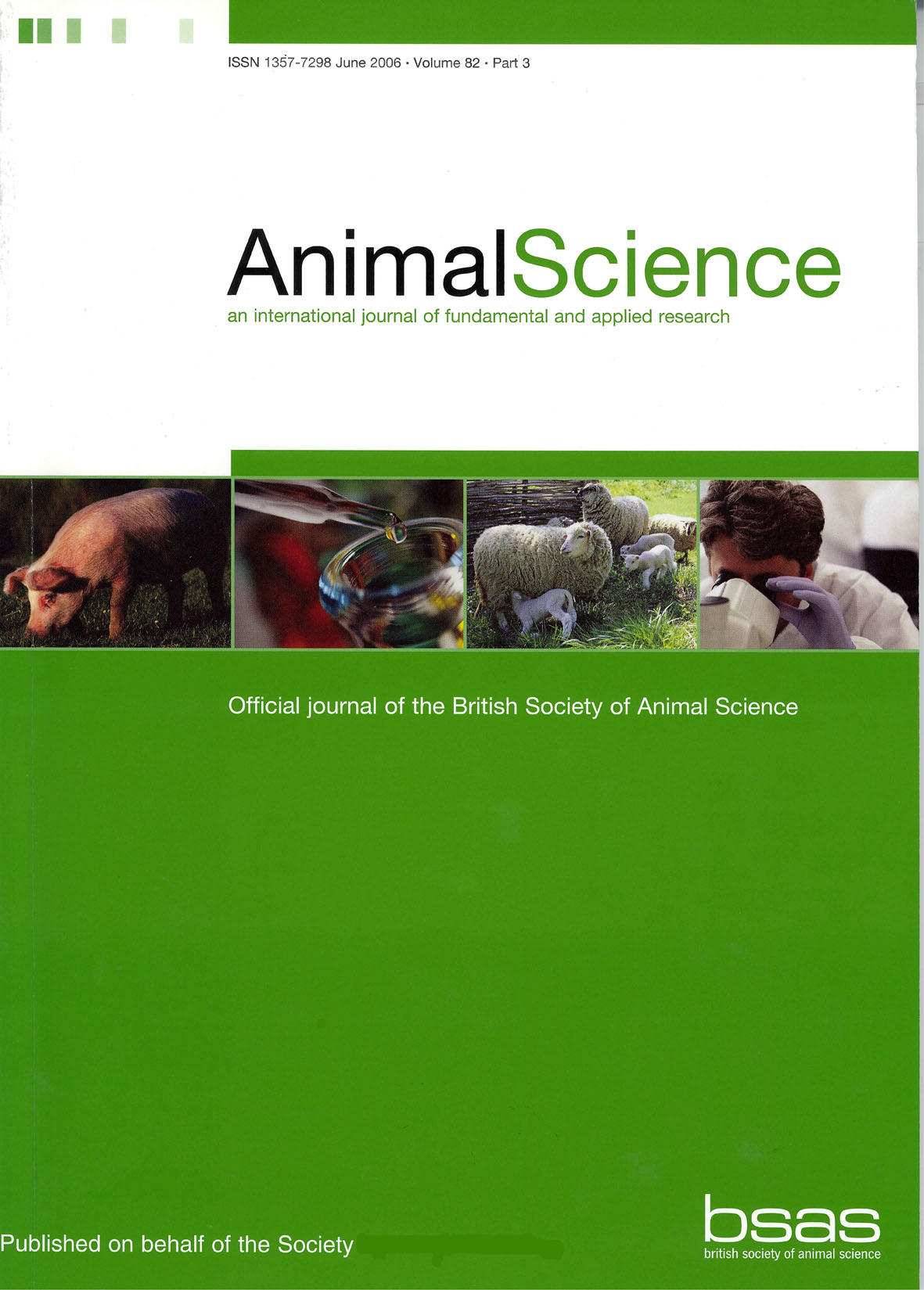Crossref Citations
This article has been cited by the following publications. This list is generated based on data provided by
Crossref.
Kirkland, R.M.
Patterson, D.C.
Keady, T.W.J.
Moss, B.W.
and
Steen, R.W.J.
2007.
Beef production potential of Norwegian Red and Holstein-Friesian bulls slaughtered at two ages.
Animal,
Vol. 1,
Issue. 10,
p.
1506.
Clarke, A.M.
Drennan, M.J.
McGee, M.
Kenny, D.A.
Evans, R.D.
and
Berry, D.P.
2009.
Live animal measurements, carcass composition and plasma hormone and metabolite concentrations in male progeny of sires differing in genetic merit for beef production.
Animal,
Vol. 3,
Issue. 7,
p.
933.
Keane, M.G.
and
Drennan, M.J.
2009.
Effects of supplementary concentrate level in winter, and subsequent finishing on pasture or indoors, on performance and carcass traits of Holstein–Friesian, Aberdeen Angus×Holstein–Friesian and Belgian Blue×Holstein–Friesian steers.
Livestock Science,
Vol. 121,
Issue. 2-3,
p.
250.
Clarke, A.M.
Drennan, M.J.
McGee, M.
Kenny, D.A.
Evans, R.D.
and
Berry, D.P.
2009.
Intake, live animal scores/measurements and carcass composition and value of late-maturing beef and dairy breeds.
Livestock Science,
Vol. 126,
Issue. 1-3,
p.
57.
Dawson, L.E.R.
Fearon, A.M.
Moss, B.W.
and
Woods, V.B.
2010.
Effects of substitution of a proportion of the concentrate in grass silage/concentrate-based diets with extruded linseed on performance and meat quality of dairy bulls.
Animal Feed Science and Technology,
Vol. 156,
Issue. 1-2,
p.
10.
Blanco, M.
Joy, M.
Panea, B.
Albertí, P.
Ripoll, G.
Carrasco, S.
Revilla, R.
and
Casasús, I.
2012.
Effects of the forage content of the winter diet on the growth performance and carcass quality of steers finished on mountain pasture with a barley supplement.
Animal Production Science,
Vol. 52,
Issue. 9,
p.
823.
Cerino-Limón , Guadalupe
García-Elizondo , Roberto
López-Trujillo , Ramiro
Fuentes-Rodríguez , Jesús M.
and
Ruiz-Zarate , Fernando
2012.
Características del animal vivo relacionadas con los grados de calidad y rendimiento de la canal de novillos engordados en corral .
Revista Agraria,
Vol. 9,
Issue. 1,
p.
15.
Nogalski, Zenon
Wielgosz-Groth, Zofia
Purwin, Cezary
Nogalska, Anna
Sobczuk-Szul, Monika
Winarski, Rafał
and
Pogorzelska, Paulina
2014.
The Effect of Slaughter Weight and Fattening Intensity on Changes in Carcass Fatness in Young Holstein-Friesian Bulls.
Italian Journal of Animal Science,
Vol. 13,
Issue. 1,
p.
2824.
Lambertz, C.
Farke-Röver, A.
Moors, E.
and
Gauly, M.
2015.
Effects of castration and weaning conducted concurrently or consecutively on behaviour, blood traits and performance in beef calves.
Animal,
Vol. 9,
Issue. 1,
p.
122.
Ripoll, Guillermo
Albertí, Pere
Alvarez-Rodríguez, Javier
Blasco, Isabel
and
Sanz, Albina
2016.
Body size, carcass and meat quality of three commercial beef categories of ‘Serrana de Teruel’ breed.
Spanish Journal of Agricultural Research,
Vol. 14,
Issue. 3,
p.
e0604.
Campos, Letícia Marra
Almeida, Amélia Katiane
Biagioli, Bruno
Resende, Kleber Tomas
and
Teixeira, Izabelle Auxiliadora Molina Almeida
2017.
Predicting empty body weight in growing goats: A meta-analytic approach.
Small Ruminant Research,
Vol. 155,
Issue. ,
p.
45.
Blanco, M.
Ripoll, G.
Delavaud, C.
and
Casasús, I.
2020.
Performance, carcass and meat quality of young bulls, steers and heifers slaughtered at a common body weight.
Livestock Science,
Vol. 240,
Issue. ,
p.
104156.
Rutherford, Naomi H.
Gordon, Alan W.
Arnott, Gareth
and
Lively, Francis O.
2020.
The Effect of Beef Production System on the Health, Performance, Carcass Characteristics, and Meat Quality of Holstein Bulls.
Animals,
Vol. 10,
Issue. 10,
p.
1922.
Rutherford, Naomi H.
Lively, Francis O.
and
Arnott, Gareth
2021.
A Review of Beef Production Systems for the Sustainable Use of Surplus Male Dairy-Origin Calves Within the UK.
Frontiers in Veterinary Science,
Vol. 8,
Issue. ,
Nian, Y.
Moloney, A. P.
Li, C.
Allen, P.
Harrison, S. M.
Prendiville, R.
Kerry, J. P.
Zhou, G.
and
Purchas, Roger
2021.
A comparison of meat composition, tenderness and the fatty acid profile of three muscles from Holstein-Friesian bulls from production system resulting in final ages of either <16 or 19 months.
Animal Production Science,
Vol. 62,
Issue. 4,
p.
368.
Fajardo, Stefanie
and
Ungerfeld, Rodolfo
2021.
Bull-bull mounts in Holstein bulls: a survey of its incidence, possible causes, and consequences in Uruguayan bull’ breeders.
Animal Reproduction,
Vol. 18,
Issue. 1,

